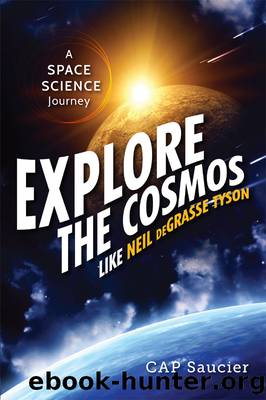Explore the Cosmos Like Neil deGrasse Tyson by CAP Saucier

Author:CAP Saucier
Language: eng
Format: epub
ISBN: 9781633880153
Publisher: Prometheus
Published: 2015-07-28T00:00:00+00:00
Jupiter with its moon Ganymede. (Image from NASA, ESA, and E. Karkoschka [University of Arizona])
Behold a majestic moonless night
Orion the Hunter rising high
Led by Jupiter in its brilliance
Across the darkened sky.
âNeil deGrasse Tyson, http://www.twitter.com,
@neiltyson, November 26, 2011
Jupiter
Appropriately, the planet that is larger than all the other planets put together is named for the king of the Roman gods. Jupiter is eleven times bigger in diameter than Earth. It also is five times farther from the sun, so it takes Jupiter twelve Earth years to circle the sun one time. Far away Jupiter is so big that it is the fourth-brightest object in our sky, after the sun, moon, and Venus, all of which are much closer.
Jupiter is a gas giant with a small core of metal and rock. The planet is made mainly of hydrogen and helium, similar to the sun. Astrophysicists call Jupiter a failed star. It just is not big enough to have the high temperatures and immense pressure needed to cause nuclear fusion to light up its gases like a star.
Jupiter emits a great deal of invisible infrared radiation. The planet sends out more energy than it receives from solar light; there are so many particles trapped in its magnetic field, and the radiation is so intense, it can damage electronic parts of space vehicles or kill people. Scientists will need to address this when astronauts are sent that far into space.
Because of its great size, Jupiter has the strongest gravity of all the planets. Comets often are pulled into Jupiter or are thrown in different directions by the strength of Jupiter's gravity. Earthlings should be grateful that Jupiter's gravity slingshots away plenty of comets and space debris heading toward us.
Jupiter is quite beautiful when viewed through a telescope. Its surface is covered with powerful storms. Probably its most famous feature, the Great Red Spot, is a hurricane twice the size of Earth that has lasted for hundreds of years.1 The atmosphere is marked with stripes of dark, warm clouds and light, cold clouds. Jupiter has a system of thin rings surrounding the planet made up of tiny particles of sand and dust.
With sixty-five moons, Jupiter presently has more than any other planet. It trades places with Saturn concerning the most moons as new moons are discovered. There are so many moons orbiting Jupiter that space scientists think of it as a miniature solar system. We can see the four Galilean moons, named after Galileo, who discovered them, by telescope.
For seven years beginning in 1995, spacecraft Galileo visited Jupiter and its many moons. The mission sent back one-of-a-kind images and, with the help of several other telescopes, made amazing discoveries of a comet smashing into the planet.2 It revealed the possibility of liquid oceans on some of the moons. Another mission by NASA, named Juno, is planned for 2016. Juno is a solar-powered spacecraft that will circle Jupiter and add to our knowledge about this magnificent orb.
Download
This site does not store any files on its server. We only index and link to content provided by other sites. Please contact the content providers to delete copyright contents if any and email us, we'll remove relevant links or contents immediately.
| Aeronautics & Space | Astronomy |
GQ GQ. Where Are You? by Sharon Ritt(786)
Mrs. dalloway by Virginia Woolf(572)
Love Potion #8 (Avatar: The Last Airbender) by Nickelodeon Publishing(533)
Everything About Astronauts Vol 1 8DEC21 by Jennings Marianne(404)
Carl Hiaasen 4-Book Collection by Carl Hiaasen(182)
The Earth Kingdom Chronicles: The Tale of Aang by Nickelodeon Publishing(182)
Crystals and Gemstones by Patience Coster & Tracey Kelly(181)
The Earth Kingdom Chronicles: The Tale of Azula by Nickelodeon Publishing(169)
March of the Blue Moon by Elaine Donadio(166)
Clean Code Principles and Patterns, 2nd Edition by Petri Silen(165)
The Earth Kingdom Chronicles: The Tale of Zuko by Nickelodeon Publishing(164)
The Earth Kingdom Chronicles: The Tale of Katara by Nickelodeon Publishing(158)
The Periodic Table by Lisa Regan(157)
The Earth Kingdom Chronicles: The Tale of Toph by Nickelodeon Publishing(156)
My Name is River by Emma Rea(153)
Super Science Projects You Can Make and Share by Mari Bolte(148)
The Secret Deep by Lindsay Galvin(146)
Blizzard! by Jake Maddox(145)
Explore the Cosmos Like Neil deGrasse Tyson by CAP Saucier(144)
